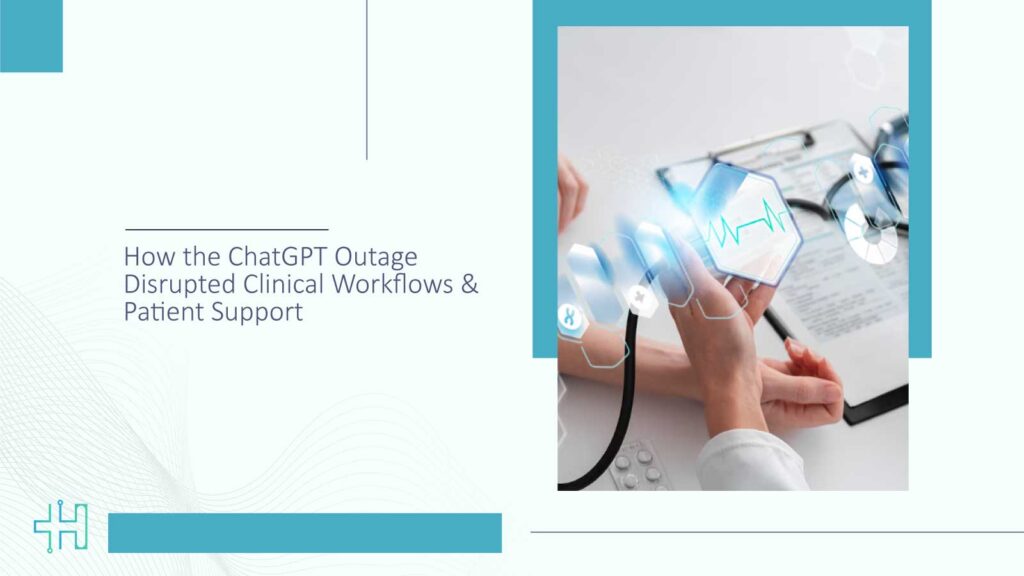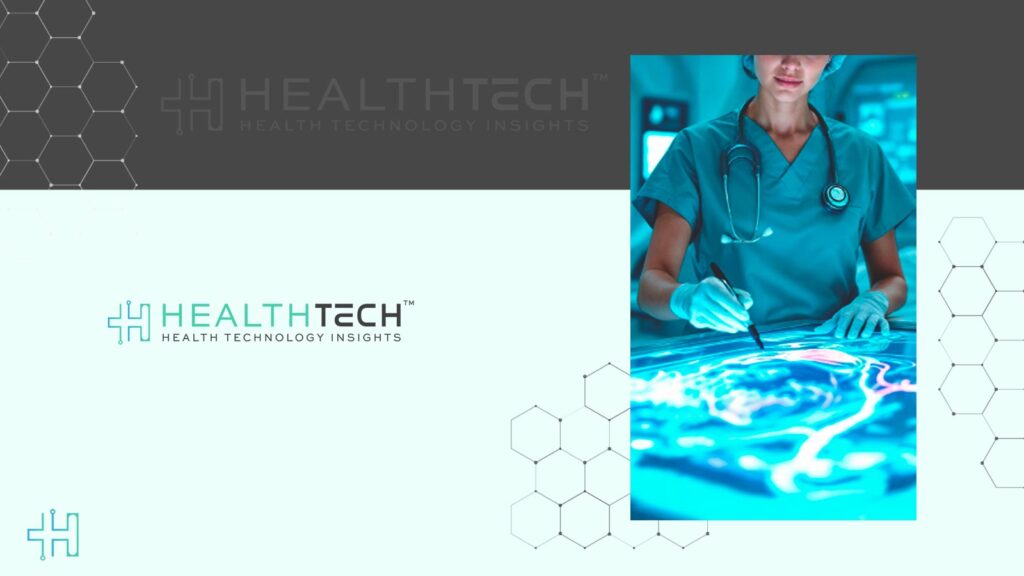You know that moment when your Wi-Fi drops mid-video call or your phone’s GPS freezes just before a turn? Now imagine that, but in a hospital ER. On June 10, 2025, millions of people around the world woke up to a surprising silence from ChatGPT.
No responses, summaries, or support. It was the largest and longest outage in the tool’s history, clocking in at around 12 hours, and it hit harder than many expected, especially inside healthcare systems that had come to rely on generative AI for everything from triage to patient messaging.
That day, how the ChatGPT outage disrupted clinical workflows and patient support, became more than a headline; it became a moment of reflection for health tech leaders, clinicians, and patients alike. When a tool this powerful goes dark, it doesn’t just impact convenience. It reveals just how deep our dependency runs and how urgently we need a plan B.
ChatGPT Was Doing More Than You Thought
For many outside the industry, ChatGPT might seem like a chatbot that tells jokes or summarizes meetings. But inside hospitals and health tech platforms, it’s much more than that.
In fact, over 30% of large healthcare systems now use generative AI to:
- Sort and triage patient symptoms before appointments.
- Help radiologists interpret scans.
- Translate health instructions into plain English.
- Schedule appointments and answer common patient questions.
- Pull insights from complex EHRs at lightning speed.
So when the lights went out, it wasn’t just a glitch; it was like removing the front desk, part of the care team, and your digital assistant all at once.
At one major hospital in Boston, elective procedures were delayed because scheduling bots stopped working. Some nurses spent the day calling patients by hand, a reminder that analog systems still matter when digital ones collapse.
When AI Fails, Who Picks Up the Pieces?
Let’s not sugarcoat it, when ChatGPT went down, people felt it. Emergency departments reported longer triage times because their AI-powered intake assistants couldn’t process symptoms. In rural clinics, where AI translation tools often bridge language barriers, patients were left waiting or misunderstood.
A user on X (formerly Twitter) posted during the outage:
“Is ChatGPT down for anyone else? I’m a cardiac surgeon in the middle of heart surgery.”
That moment brought something essential into focus: AI may be impressive, but it’s not infallible. And when it fails, it’s human clinicians, staff, and patients who bear the brunt.
A Wake-Up Call for the Entire Health Tech Ecosystem
The outage didn’t just interrupt workflows; it highlighted how interwoven generative AI has become in modern healthcare.
At the peak of the disruption, more than 500 million users worldwide experienced issues accessing ChatGPT-powered tools. In hospitals, that meant AI scribes, diagnostics aids, symptom checkers, and even virtual therapists went silent.
“ChatGPT is not AGI, but it was a dress rehearsal … to see if we would be able to stop a runaway train if it were to arrive. Humanity failed,” said Gary Marcus, an AI researcher, reflecting on the outage.
In other words, speed, scale, and personalization are great, but without resilience, they’re just risks waiting to materialize.
Lessons in Resilience and Redundancy
Here’s what the industry is now talking about and acting on:
Hybrid AI Infrastructure
Instead of putting all your eggs in the cloud, some systems are exploring on-premise AI models to serve as local backups. This “hybrid AI” approach allows for continuity if a major cloud provider goes down.
At the University of Rochester Medical Center, where such a system is already in place, care teams barely missed a beat during the outage. That’s the gold standard we should be aiming for.
Human-in-the-Loop Design
AI tools must support care, not take it over entirely. That means building processes where humans oversee, verify, and can seamlessly step in when automation stumbles.
Some organizations, like Valley Medical Center, are designing systems where critical AI outputs are always reviewed by a second set of human eyes.
Stress Testing AI
Just like hospitals conduct fire drills and cybersecurity simulations, AI systems need regular failover drills. Simulate outages. See where the cracks are. And make sure everyone knows what to do when the lights go out.
Regulation, Ethics, and Smarter Deployment
Beyond technical fixes, there’s a bigger conversation about how AI should be deployed in healthcare.
Should there be national standards for AI reliability? What kind of audit trails should be mandatory for AI-generated clinical decisions? Should certain AI functions always require human validation? Health regulators and hospital boards are now discussing AI governance frameworks.
Thought leaders like Dr. John Halamka of the Mayo Clinic Platform have advocated for “ethical guardrails” and stress testing, saying: “We need to treat AI as part of the clinical team with all the accountability that comes with that.”
That doesn’t mean slowing innovation. It means innovating responsibly.
Embracing Humanity in Healthcare Amidst Digital Disruptions
As disruptive as the outage was, it also sparked something encouraging: community. On social media, nurses shared tips for handwritten note-taking. Doctors shared patient scheduling templates. IT teams posted open-source guides to AI fallback plans. And health tech vendors got real about where their tools succeeded or failed during the outage.
We saw a moment of humility and collaboration that doesn’t always make the headlines. But it matters. It reminded us that behind every algorithm are humans trying to care for other humans, and that’s worth protecting, with or without AI.
AI Is Here to Stay, So Let’s Make It Stronger
Generative AI isn’t going anywhere. The benefits are too significant. It reduces burnout, improves documentation, enhances patient communication, and personalizes care in powerful ways.
But moments like this one, when the ChatGPT outage disrupted clinical workflows and patient support, are necessary reminders that convenience can’t outweigh continuity.
Healthtech leaders now face a clear next step: design systems that are not just smart, but resilient. Build AI solutions that know how to fail safely. And most importantly, never forget that healthcare is about people, not just processing power.
As we look ahead, let’s build a future where AI is a trusted partner but never the only one in the room.
FAQs
1. Was the ChatGPT outage a big deal for healthcare, or is this being overhyped?
It mattered. While no lives were reported lost and critical care continued, the outage revealed how deeply AI tools like ChatGPT have been woven into day-to-day operations, from scheduling and triage to clinical note drafting and patient communication.
2. What specific tasks in healthcare are being handled by ChatGPT or similar AI tools today?
You’d be surprised! Many hospitals and clinics use generative AI for patient intake forms, symptom checking, appointment scheduling, medical translations, and even summarizing physician notes.
3. How did the outage affect patients directly? Did it delay care?
For many patients, it meant longer wait times, fewer updates, and some canceled or delayed appointments, especially where AI tools handled scheduling or automated communication. One mother even posted online about waiting 40 minutes on hold because her usual self-service tool was offline.
4. Are hospitals doing anything now to prevent future disruptions like this?
Yes, and fast. Many are now investing in hybrid AI systems that combine cloud-based and local (on-prem) models so that operations can continue if a major platform goes down. Some are also training staff in manual backups and “AI downtime” protocols similar to how we run fire drills.
5. Does this mean AI isn’t reliable for healthcare after all?
Not at all, it means we need to be smarter about how we use it. Just like electricity or the internet, AI can dramatically enhance healthcare, but it needs safeguards and contingency plans.
Dive deeper into the future of healthcare.
Keep reading on Health Technology Insights.
To participate in our interviews, please write to our HealthTech Media Room at sudipto@intentamplify.com




